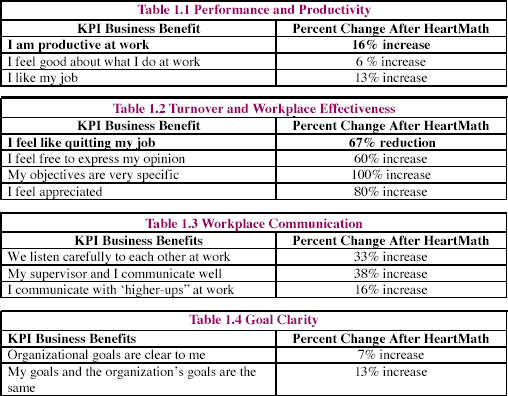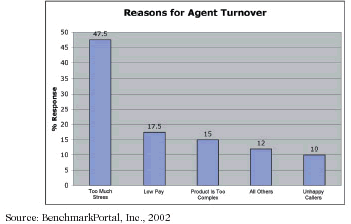A Fortune 50 High Tech Firm--Call Center
Building A High Performance Contact Center
Reducing Stress, Turnover And Increasing Productivity,
Morale And Customer Satisfaction
I. Executive Summary
This case study reports on the Key Performance
Indicators (KPIs) measured before and after a HeartMath
training program in a Fortune 50 High Tech Firm's
technical support call center. This call center was
the frontline of technical support for the company's
technology product lines. The business goals of the
program were to reduce stress, improve communication
and improve morale of the technical support group,
thereby leading to increased customer satisfaction
and loyalty. By training the technical personnel to
be able to recalibrate their stress levels after difficult
calls, it was also expected that turnover would decrease
and productivity would increase. The total estimated
savings realized by the firm from the HeartMath training
program was $632,539.
The changes in the KPIs based upon those who reported in the categories of "often" or "most of the time" were:
- 67% reduction in intent to leave the job (decrease in turnover)
- 16% increase in productivity
- 100% reduction in stress, anger, exhaustion, tension and depression
- 38% improvement in communication between staff and managers
- 33% improvement in listening to customers and fellow employees
- 36% improvement in feeling cared about by the organisation.
The key driver of these results was: participants learned techniques that were used in real-time to transform their physiological reactions from stress, thereby boosting their performance when dealing with customers and co-workers. In addition, several individuals who were on high blood pressure medication were able to reduce or stop taking the medication after the training (with doctor's approval). While potentially significant, the outcomes of the health care cost savings were not tracked in this study.
II. ROI Calculations
The Technical Call Center group's goal was to
solve the customer's issues in the first call and,
thereby, increase the number of "First and Done Calls."
At times the issues could not be solved and were escalated.
Problems not resolved in the first call would upset
some customers. As a result, the Call Center group
would feel pressure when they could not satisfy the
customer immediately. At times, when operating under
reduced staff situations, the group felt overloaded
with calls and stretched for resources. As a result
of the difficulties on the job, anxiousness and concern
were common complaints. The Senior Manager of the
Education Department was concerned about costly turnover
and looked for a proactive solution.
The following tables are the changes in KPI metrics over a period of 60 days. Baseline measurements were taken before the HeartMath program started. After 60 days, the same group of people was measured again. This program generated benefits for the entire call center group, especially those that were most discontent or least satisfied.

The following calculations are the potential return on investment for a reduction in turnover and an increase in productivity for two of the measured changes in KPIs.
Business Benefit ROI #1: Increased Productivity
Assumptions:
1. The salary of a Technical Call Center Professional
was $51,120.
Calculations:
From Table 1.1, out of 27 people, the increase
in productivity was 16%.
The value of the increase in productivity is calculated
in the following manner:
Productivity before HeartMath was at 84%.
27 x $51,120 salary/Technical Call Center Professional/year
x (.84) productive before HeartMath =$1,159,401.
Productivity after HeartMath was at 100%.
27 x $51,120 salary/Technical Call Center Professional/year
x (1) productive after HeartMath = $1,380,240.
Benefit of Solution = Difference in Productivity = $220,839.
Cost of Solution = Cost of training 27 people = $25,000.
ROI = Benefit of Solution - Cost of Solution x 100
Cost
of Solution
ROI = ($220,839 - $25,000) = $195,839 = 7.83 x 100
= 783%
$25,000
$25,000
This means that for every $1.00 spent on HeartMath, $7.83 was potentially saved through productivity gains.
Total potential productivity savings after HeartMath training = $195,839.
Note: Even if the gain in productivity was only 1/3 of the reported value, the ROI would still be approximately 261%, or result in a total potential savings of $65,279 for one year.
Business Benefit ROI #2: Reduce Turnover
Assumptions:
1. Actual Technical Call Center Professional replacement
costs per person in the Fortune 50 High Tech Firm
were reported as $25,650. (Actual call center
turnover costs may vary from center to center. In
2003, Purdue University's Center for Customer Driven
Quality states that replacements costs are $6,350
per individual.)
2. The average salary of each Technical Call Center
Professional was $51,120.
Calculations:
From Table 1.2, out of 27 people, a 67% reduction
in intention to quit their job means that there was
a cost benefit of not replacing 18 people. (27 x .67
= 18.09 = 18)
Benefit of Solution = 18 people x $25,650 = $461,700 in replacement costs
Cost of Solution = Cost of training 27 people = $25,000
ROI = Benefit of Solution - Cost of Solution x 100
Cost
of Solution
ROI = ($461,700- $25,000) = $436,700 = 17.47
x 100 = 1747%
$25,000
$25,000
This means that for every $1.00 spent on HeartMath, $17.47 was potentially saved in replacement costs for these Technical Call Center Professionals. Total potential savings after HeartMath training = $436,700.
Note: Even if the savings from replacement costs were only 1/3 of the reported value, the ROI would still be approximately 582%, or result in a total potential savings of $145,566 for one year.
III. Observations
Current industry research from Purdue University's
Center for Customer Driven Quality and BenchmarkPortal,
Inc. states that the number one reason Technical Call
Center Professionals leave their jobs is due to stress.

Figure 1. Stress--the number one reason for turnover.
Before the HeartMath Program:
Pre-program surveys revealed the following percentages
of participants reporting "often" or "most of the
time": 27% were tense, 19% were depressed, 18% were
unhappy, 14% were sad, 9% were angry.
From other research conducted by HeartMath, it has become well established that stress experienced on the job causes changes in the physiology of workers and executives alike, in this case the Technical Call Center Professional. Those stress-induced changes in physiology often result in people leaving and less productivity on the job. Prior to the HeartMath training, average performance in this group had resulted in increased operating costs and more customer complaints. People leaving resulted in a reduction in staff. Therefore, the remaining staff was unable to reach Customer Service business goals. Increased operating costs also increased due to additional recruiting and retraining costs resulting from the turnover. This High Tech Firm recognised that personnel performance issues had been directly related to the pace of their business and that was costly for their Customer Service organisation and for the corporation.
After the HeartMath Program:
After the HeartMath program, post program surveys
of the same participants revealed: 0% were tense,
0% were depressed, 0% were unhappy, 0% were sad, 0%
were angry (based on "often" or "most of the time"
responses.)
The Technical Call Center Professional and managers reported being able to monitor, measure and control their own stress levels, thereby feeling more in control of their unpredictable environment and the pace. They felt more equipped to provide improved customer service under stressful situations.
IV. Conclusion| Total Savings for this High Tech Firm after HeartMath Training Program | |
| $436,700 - | Reduced Turnover |
| + $195,839 - | Increased Productivity |
| $632,539 | Total Estimated annualised Savings measured over 60 days |
(Note: Even the most conservative estimates, 1/3 of total savings = $210,846.)
V. Recommendations:
In future HeartMath programs at this site, it
is recommended that the sample group be measured to
include all results achieved beyond the pilot and
compare this data to a control group not receiving
HeartMath Training to factor other variables in the
environment. We understand that 350 people were trained
after the initial pilot. Include KPIs in the baseline
measurement to associate the decrease of health care
costs and benefits to the organisation, i.e., increased
time on the job, decrease in absenteeism, etc.
Testimonials about the HeartMath Training Program
from Fortune 50 High Tech Firm
"In dealing with customers, our group
is under stress all the time. Members of the team
have said, 'Communication with their managers is more
effective after the HeartMath training.' Also, prior
to HeartMath, a lot of people had said they were thinking
about leaving the organisation. After the HeartMath
training, they aren't thinking of quitting anymore.
The quality of people's lives is improved as people
are less stressed at the end of the day. They have
more energy to work better with customers and also
have more energy for their family when they leave
work."
"I personally am more efficient at work and in how I balance my time. Specifically, in a group I listen with more clarity for core messages so that we can focus meetings effectively. Essentially, I have become more efficient at getting to solutions. These tools are universal. Wherever you are these tools work."
--Program Manager/Education Department
"In our high-pressure customer service jobs, Freeze-Frame® is fantastic technology. We are able to give customers time to vent using our intuitive listening skills. Since we have had our entire team using HeartMath, we have an 80% improvement in our focus on the business problem at hand. We draw on our full creativity."
--Technical Call Center Professional
For Information
Telephone: (02) 9412 2500 (Australia)
Telephone: +61 2 9412 2500 (International)
E-Mail: info@macquarieinstitute.com.au
![]() Download our PDF
Brochure
Download our PDF
Brochure